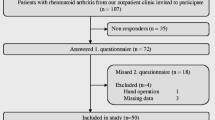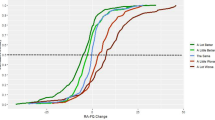Abstract
Objective
To evaluate use of a British English version of the validated French FLARE-RA questionnaire among American English speaking patients. In addition, to create a culturally adapted American English (AmE) FLARE-RA questionnaire and to examine its attributes of patient-reported RA flare status.
Methods
Using standardized cultural adaptation guidelines, we cognitively debriefed 25 American English speaking rheumatoid arthritis (RA) outpatients and created AmE-FLARE-RA with their input. One hundred three additional RA patients were recruited. Patients completed the Routine Assessment of Patient Index Data 3 (RAPID3), patient global visual analogue scale (VAS), AmE-FLARE-RA, and self-reports of flare. Physician global VAS, physician-assessed flare, swollen and tender joint count (TJC), and clinical disease activity index (CDAI) were documented. AmE-FLARE-RA and disease activity measures were compared between patient-reported and physician-reported flare categories.
Results
Patients were female (89%), with mean (SD) age 51.1 (± 15.3) years and mean disease duration (SD) 11.9 (± 10.1) years, with 26% in remission/low disease activity. Total AmE-FLARE-RA scores, RAPID3, CDAI, and patient global VAS were significantly higher for both patient-reported flares and physician-reported flares compared with non-flaring patients by self- or physician report (p < 0.05). Total AmE-FLARE-RA scores correlated significantly with RAPID3 (corr = 0.50, p < 0.0001) and with CDAI (corr = 0.45, p < 0.0001). Across “no flares,” “one flare,” and “several flare” groups, there was a non-significant increase in AmE-FLARE-RA scores (p = 0.07).
Conclusion
The British English FLARE-RA was successfully adapted for AmE-speaking RA patients. AmE-FLARE-RA significantly correlated with RAPID3 and CDAI and distinguished between patient-reported and physician-reported flares, making it useful to detect flares in American RA patients.
Key Points • The American English FLARE-RA (AmE-FLARE-RA) questionnaire is the result of cognitive debriefing with American RA patients using the British English version of the validated French FLARE-RA and incorporates patient-recommended language modifications.. • Patients self-reporting flares had significantly higher AmE-FLARE-RA scores, compared with those without flares at the time of visit. AmE-FLARE-RA scores correlate with RAPID3 and CDAI. • There was a non-statistically significant trend using the AmE-FLARE-RA scores when examining patients with no flare, one flare, or several flares. • AmE-FLARE-RA total scores are uniformly elevated (~ 6.0 on a 0–10 scale), regardless of discordance between patient and MD assessment of flare at time of visit (~ 30%) |

Similar content being viewed by others
References
Smolen JS, Aletaha D, McInnes IB (2016) Rheumatoid arthritis. Lancet 388(10055):2023–2038. https://doi.org/10.1016/s0140-6736(16)30173-8
Hewlett S, Sanderson T, May J, Alten R, Bingham CO 3rd, Cross M, March L, Pohl C, Woodworth T, Bartlett SJ (2012) “I’m hurting, I want to kill myself”: rheumatoid arthritis flare is more than a high joint count--an international patient perspective on flare where medical help is sought. Rheumatology (Oxford) 51(1):69–76. https://doi.org/10.1093/rheumatology/keq455
Markusse IM, Dirven L, Gerards AH, van Groenendael JH, Ronday HK, Kerstens PJ, Lems WF, Huizinga TW, Allaart CF (2015) Disease flares in rheumatoid arthritis are associated with joint damage progression and disability: 10-year results from the BeSt study. Arthritis Res Ther 17:232. https://doi.org/10.1186/s13075-015-0730-2
Myasoedova E, Chandran A, Ilhan B, Major BT, Michet CJ, Matteson EL, Crowson CS (2016) The role of rheumatoid arthritis (RA) flare and cumulative burden of RA severity in the risk of cardiovascular disease. Ann Rheum Dis 75(3):560–565. https://doi.org/10.1136/annrheumdis-2014-206411
van den Brandt S, Zbinden A, Baeten D, Villiger PM, Ostensen M, Forger F (2017) Risk factors for flare and treatment of disease flares during pregnancy in rheumatoid arthritis and axial spondyloarthritis patients. Arthritis Res Ther 19(1):64. https://doi.org/10.1186/s13075-017-1269-1
Ometto F, Raffeiner B, Bernardi L, Bostsios C, Veronese N, Punzi L, Doria A (2016) Self-reported flares are predictors of radiographic progression in rheumatoid arthritis patients in 28-joint disease activity score remission: a 24-month observational study. Arthritis Res Ther 18:89. https://doi.org/10.1186/s13075-016-0986-1
Bartlett SJ, Bykerk VP, Cooksey R, Choy EH, Alten R, Christensen R, Furst DE, Guillemin F, Halls S, Hewlett S, Leong AL, Lyddiatt A, March L, Montie P, Orbai AM, Pohl C, Voshaar MS, Woodworth TG, Bingham CO 3rd (2015) Feasibility and domain validation of rheumatoid arthritis (RA) flare core domain set: report of the OMERACT 2014 RA flare group plenary. J Rheumatol 42(11):2185–2189. https://doi.org/10.3899/jrheum.141169
Bingham CO 3rd, Pohl C, Woodworth TG, Hewlett SE, May JE, Rahman MU, Witter JP, Furst DE, Strand CV, Boers M, Alten RE (2009) Developing a standardized definition for disease “flare” in rheumatoid arthritis (OMERACT 9 Special Interest Group). J Rheumatol 36(10):2335–2341. https://doi.org/10.3899/jrheum.090369
Choy EH, Khoshaba B, Cooper D, MacGregor A, Scott DL (2008) Development and validation of a patient-based disease activity score in rheumatoid arthritis that can be used in clinical trials and routine practice. Arthritis Rheum 59(2):192–199. https://doi.org/10.1002/art.23342
van der Maas A, Lie E, Christensen R, Choy E, de Man YA, van Riel P, Woodworth T, den Broeder AA (2013) Construct and criterion validity of several proposed DAS28-based rheumatoid arthritis flare criteria: an OMERACT cohort validation study. Ann Rheum Dis 72(11):1800–1805. https://doi.org/10.1136/annrheumdis-2012-202281
Berthelot JM, De Bandt M, Morel J, Benatig F, Constantin A, Gaudin P, Le Loet X, Maillefert JF, Meyer O, Pham T, Saraux A, Solau-Gervais E, Spitz E, Wendling D, Fautrel B, Guillemin F, SgoFSo R (2012) A tool to identify recent or present rheumatoid arthritis flare from both patient and physician perspectives: the ‘FLARE’ instrument. Ann Rheum Dis 71(7):1110–1116. https://doi.org/10.1136/ard.2011.150656
Fautrel B, Morel J, Berthelot JM, Constantin A, De Bandt M, Gaudin P, Maillefert JF, Meyer O, Pham T, Saraux A, Solau-Gervais E, Vittecoq O, Wendling D, Erpelding ML, Guillemin F, Rheumatology SGotFSo (2017) Validation of FLARE-RA, a self-administered tool to detect recent or current rheumatoid arthritis flare. Arthritis Rheumatol 69 (2):309–319. doi:https://doi.org/10.1002/art.39850
de Thurah A, Maribo T, Stengaard-Pedersen K (2016) Patient self-assessment of flare in rheumatoid arthritis: criterion and concurrent validity of the flare instrument. Clin Rheumatol 35(2):467–471. https://doi.org/10.1007/s10067-014-2849-y
Maribo T, de Thurah A, Stengaard-Pedersen K (2016) Patient-self assessment of flare in rheumatoid arthritis: translation and reliability of the flare instrument. Clin Rheumatol 35(4):1053–1058. https://doi.org/10.1007/s10067-014-2848-z
Aletaha D, Neogi T, Silman AJ, Funovits J, Felson DT, Bingham CO, Birnbaum NS, Burmester GR, Bykerk VP, Cohen MD, Combe B, Costenbader KH, Dougados M, Emery P, Ferraccioli G, Hazes JMW, Hobbs K, Huizinga TWJ, Kavanaugh A, Kay J, Kvien TK, Laing T, Mease P, Ménard HA, Moreland LW, Naden RL, Pincus T, Smolen JS, Stanislawska-Biernat E, Symmons D, Tak PP, Upchurch KS, Vencovský J, Wolfe F, Hawker G (2010) 2010 rheumatoid arthritis classification criteria: an American College of Rheumatology/European League Against Rheumatism collaborative initiative. Arthritis & Rheumatism 62(9):2569–2581. https://doi.org/10.1002/art.27584
Aletaha D, Smolen J (2005) The simplified disease activity index (SDAI) and the clinical disease activity index (CDAI): a review of their usefulness and validity in rheumatoid arthritis. Clin Exp Rheumatol 23(5 Suppl 39):S100–S108
Wild D, Grove A, Martin M, Eremenco S, McElroy S, Verjee-Lorenz A, Erikson P, Translation ITFf, Cultural A (2005) Principles of good practice for the translation and cultural adaptation process for patient-reported outcomes (PRO) measures: report of the ISPOR task force for translation and cultural adaptation. Value Health 8 (2):94–104. doi:https://doi.org/10.1111/j.1524-4733.2005.04054.x
Bland JM, Altman DG (1997) Cronbach’s alpha. Bmj 314(7080):572. https://doi.org/10.1136/bmj.314.7080.572
Hooper D, Coughlan J, Mullen M (2008) Structural equation modelling: guidelines for determining model fit. Articles 2
Myasoedova E, Crowson CS, Giblon RE, McCarthy-Fruin K, Schaffer DE, Wright K, Matteson EL, Davis JM (2019) Optimization of flare management in patients with rheumatoid arthritis: results of a randomized controlled trial. Clin Rheumatol. https://doi.org/10.1007/s10067-019-04664-5
Hunter TM, Boytsov NN, Zhang X, Schroeder K, Michaud K, Araujo AB (2017) Prevalence of rheumatoid arthritis in the United States adult population in healthcare claims databases, 2004-2014. Rheumatol Int 37(9):1551–1557. https://doi.org/10.1007/s00296-017-3726-1
Kvrgic Z, Asiedu GB, Crowson CS, Ridgeway JL, Davis JM 3rd (2018) “Like no one is listening to me”: a qualitative study of patient-provider discordance between global assessments of disease activity in rheumatoid arthritis. Arthritis Care Res (Hoboken) 70(10):1439–1447. https://doi.org/10.1002/acr.23501
Challa DN, Kvrgic Z, Cheville AL, Crowson CS, Bongartz T, Mason TG 2nd, Matteson EL, Michet CJ Jr, Persellin ST, Schaffer DE, Muskardin TLW, Wright K, Davis JM 3rd (2017) Patient-provider discordance between global assessments of disease activity in rheumatoid arthritis: a comprehensive clinical evaluation. Arthritis Res Ther 19(1):212. https://doi.org/10.1186/s13075-017-1419-5
Desthieux C, Hermet A, Granger B, Fautrel B, Gossec L (2016) Patient-physician discordance in global assessment in rheumatoid arthritis: a systematic literature review with meta-analysis. Arthritis Care Res (Hoboken) 68(12):1767–1773. https://doi.org/10.1002/acr.22902
Acknowledgments
The authors thank Dr. Sarah Thomas, who facilitated cognitive debriefing interviews and managed patient recruitment. Dr. Fabrice Kwiatkowski (FK) conducted the back translation and FG and BF evaluated for cross-cultural adaptation.
Author information
Authors and Affiliations
Corresponding author
Ethics declarations
This study is in compliance with and approved by the University of California, Los Angeles (UCLA) Office of the Human Research Protection Program. Patients voluntarily signed the UCLA internal review board (IRB)-approved (#12-001784) consent.
Disclosures
None.
Additional information
Publisher’s note
Springer Nature remains neutral with regard to jurisdictional claims in published maps and institutional affiliations.
Appendices
Appendix 1
Appendix 2
Rights and permissions
About this article
Cite this article
Barroso, N., Woodworth, T.G., Furst, D.E. et al. The American English version of the validated French Flare Assessment in RA Questionnaire (FLARE-RA). Clin Rheumatol 39, 189–199 (2020). https://doi.org/10.1007/s10067-019-04755-3
Received:
Revised:
Accepted:
Published:
Issue Date:
DOI: https://doi.org/10.1007/s10067-019-04755-3




